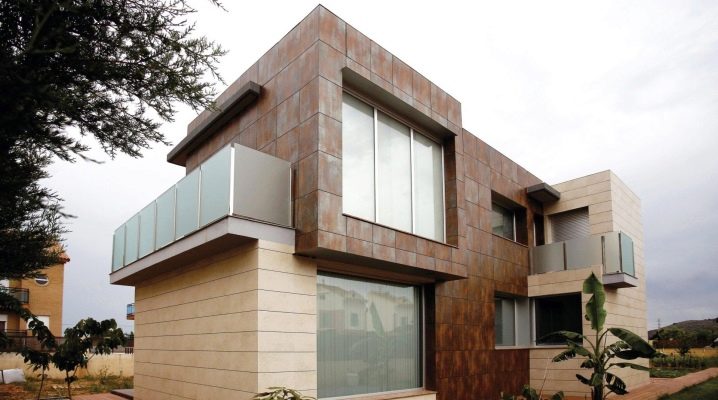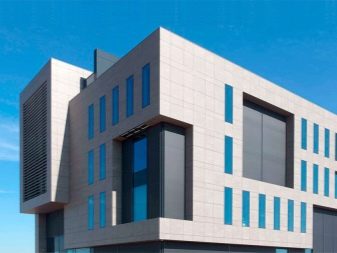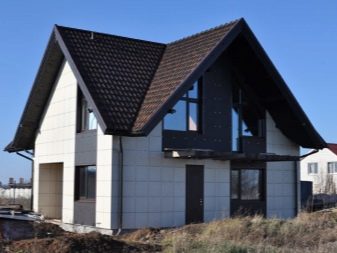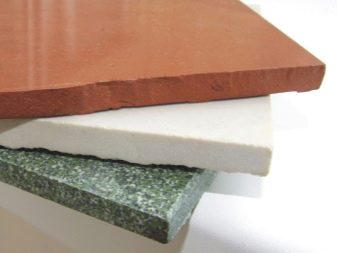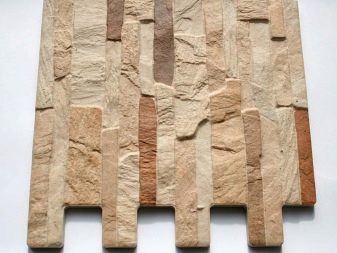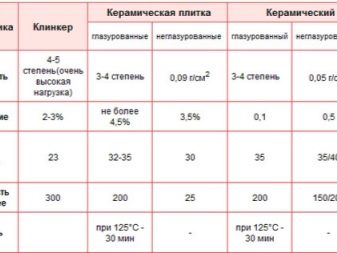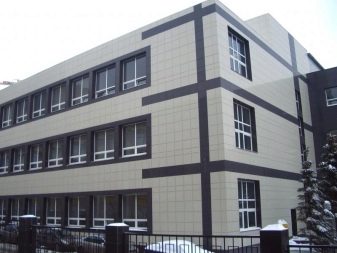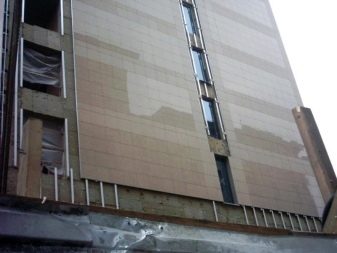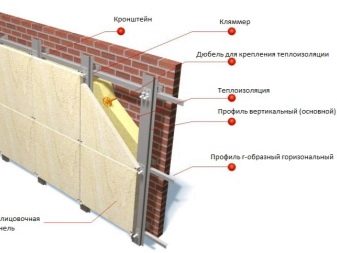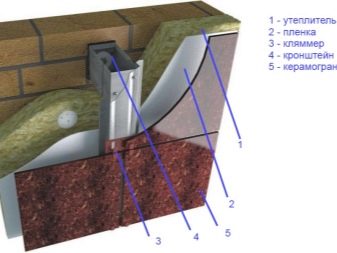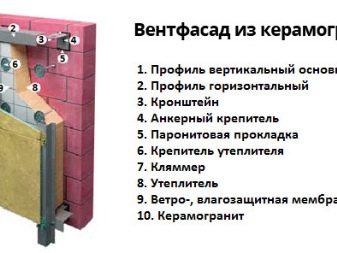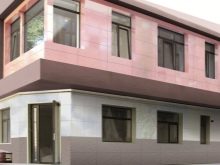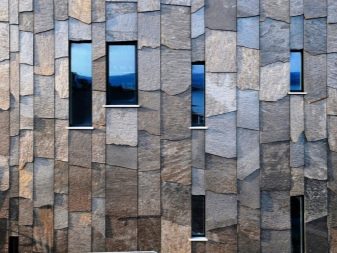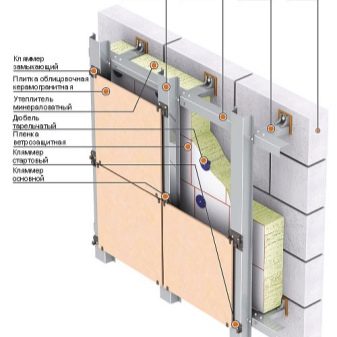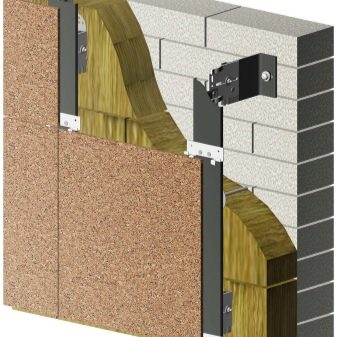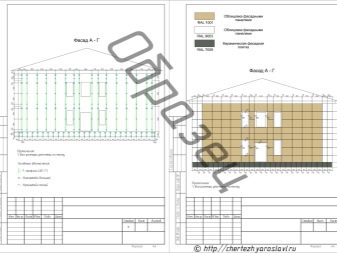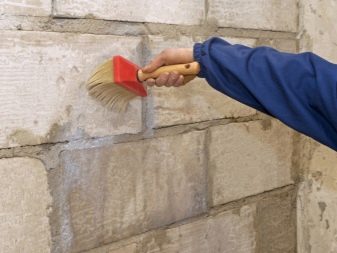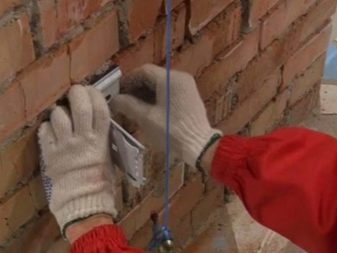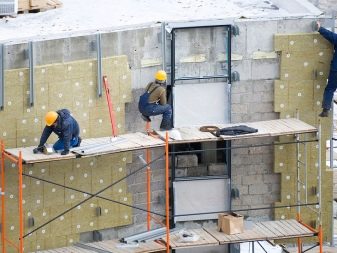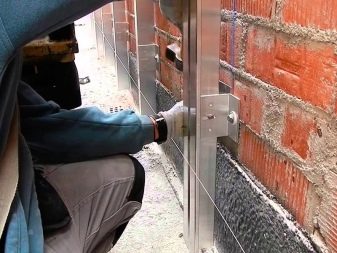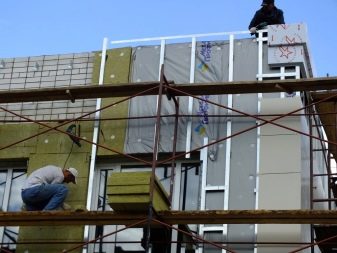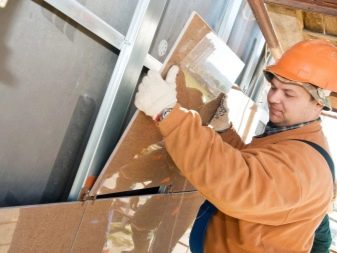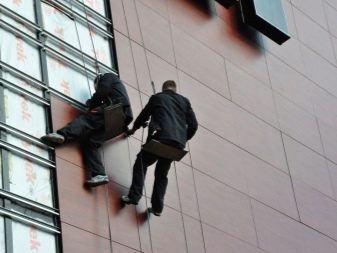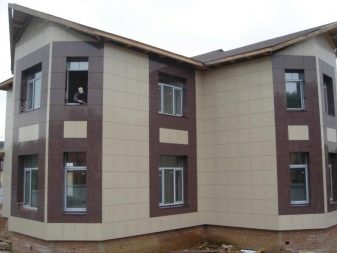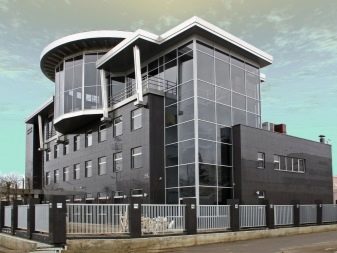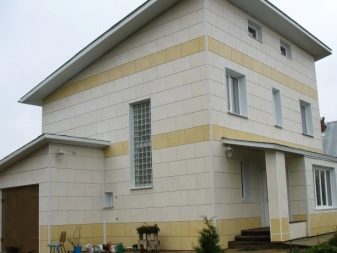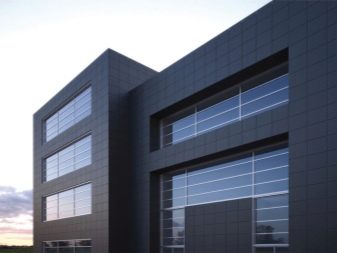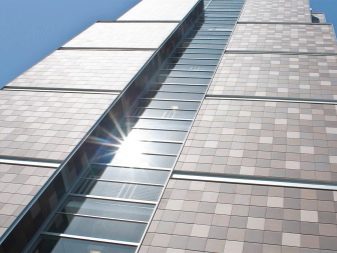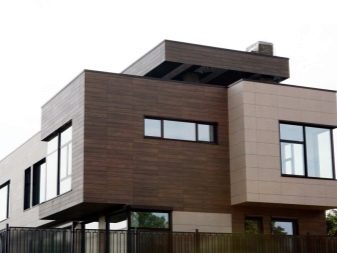Beautiful ventilated facades of porcelain: the advantages of installation for country houses
Ventilated facades with the use of ceramic granite plates were originally used only for finishing public and administrative buildings. However, the strength and durability of the material, as well as its refined and expensive appearance, quickly attracted the attention of private house owners. It is not surprising that today country cottages with veneer stoneware are becoming widely spread.
Material Features
The ventilated facade of porcelain stoneware serves to protect the walls of the building from negative environmental factors, and also performs a decorative function. The material is used to organize the hinged facade system,one of the features of which is the fastening of the finishing material on a special crate.
Curtain wall can be ventilated and non-ventilated. The first type is characterized by the presence of air space between the wall and the facade material. The advantages of the ventilated system with the use of porcelain tiles are in improving the heat and sound insulation of the building, its weather resistance, and at the same time and durability.
The use of lathing allows you to hide minor defects and irregularities of the surface being trimmed. Finally, a thermal insulation material can be installed in the airspace. In this case, the air "pillow" is formed between the outer finishing layer and a layer of insulation.
Siding, plates and porcelain stoneware popular today are used as facing materials. Let us consider in more detail what constitutes this material.
Porcelain tile is a kind of artificial stone. It consists of quartz sand, clay, feldspar, as well as dyes and modifiers. The surface of porcelain stoneware imitates the texture of natural stone.The visual similarity of the materials is surprisingly accurate - it is possible to determine an artificial analogue to a non-professional only upon close scrutiny.
Unlike natural stone, porcelain has a smaller weight, easier processing and installation method. It does not require constant care, has a smooth surface that is prone to self-cleaning, and is characterized by the absence of radiation background. Finally, the cost of porcelain tile is almost 3 times lower than the cost of the natural counterpart.
It is also worth noting such advantages of facade material as:
- high strength, resistance to environmental influences;
- increased resistance to stress (static and dynamic);
- improved sound insulation values;
- maintainability - the ability to replace only the damaged element without dismantling the entire facade;
- fire safety - the material does not burn, is not prone to spontaneous ignition, does not emit toxic substances in case of fire;
- environmental friendliness due to the natural composition;
- durability.
In comparison with other cladding materials (except for natural stone), porcelain stoneware is heavy. This implies an additional strengthening of the foundation of the building, which means an increase in the labor intensity of the process of construction and installation of the plates, as well as entails an increase in financial expenses. It should be noted that the cost of the material itself is quite high.
Device
The impressive weight of plates made of porcelain stoneware implies the manufacture of a powerful and reliable subsystem. Technological map to the material recommends using it only on an aluminum base. However, in practice, to reduce installation costs, galvanized counterparts are used. There are no official data indicating façade collapse due to such a replacement, however, one should always remember that non-compliance with the manufacturer’s recommendations carries additional risks.
The subsystem is used to install porcelain stoneware on it and to ensure the preservation of the air gap between the cladding and the wall. The basis of the subsystem is the profiles interconnected horizontally and vertically.
Fixing porcelain stoneware is usually carried out on clamps that are mounted in an open or hidden manner. The latter method is more labor intensive and contributes to an increase in the estimate, however, it is aesthetically more attractive. For work only the front tile from porcelain tile is applied.Despite the apparent strength of the floor counterpart, its use is unacceptable due to the greater thickness of the tile, and, therefore, greater weight. The thickness of the facade tile is always the same and is 10 mm.
Fastening subsystem profiles to the wall is made on the brackets. Between the crate and the wall is also installed insulation (mineral or basalt wool), and on top of it - wind-proof film. All components and fasteners must be stainless steel or have a corrosion-resistant coating.
Kinds
Depending on what method is used to veneer the subsystem, there are 2 types of ventilated ceramic-granite facades:
- glue system (plates are fixed to the crate with polyurethane glue);
- klyammernaya system (mounting porcelain stoneware on the subsystem is produced by means of fastening mechanisms)
The structure trimmed with ceramic granite may look different. In part, this depends on the type of “stone” used.
There are the following types of porcelain tiles:
- matt (the surface is not polished during the manufacturing process, so the product is non-shiny, it has the lowest cost);
- glossy (looks more elegant, respectable, the surface does not attract dust, but on it the smallest cracks and scratches are noticeable);
- satin (characterized by a variety of shades and the presence of dark patterns, which is achieved due to the deposition of mineral salt on the surface);
- semi-polished (polished with compositions with larger fractions, which reduces the cost of the product compared to the glossy counterpart);
- structural (matt, slightly rough surface with imitation of the texture of natural stone).
Differences may relate to the size of the plates. There is no single standard governing the requirements for the dimensions of the material. Usually the plates are square with sides from 40 to 80 cm. The use of smaller plates visually does not look so attractive - from a distance one gets the impression of a finely lined facade.
Mounting methods
As already mentioned, porcelain stoneware can be bonded to the crate by means of clamps or glued onto polyurethane adhesives. In addition to glue, double-sided adhesive tape is used. Its task is to keep the material until the full polymerization of the adhesive composition.
The mechanical method involves open and closed installation types. The open (visible) technology involves the use of an ordinary clip, whose antennae are quite noticeable after installation. This is the disadvantage of this method. However, the open installation type is more operational and less labor-intensive.
When the installation is closed, the porcelain tile is fastened with the help of a clamp on the guide profile. It is clear that the cost of work increases, as does its complexity. As a result, the joints between the plates and the antennae fasteners are invisible, creating the effect of a single stone wall.
The main stages of work
Installation of hinged ventilated ceramic granite facades is carried out in several stages. We present an exemplary action instruction.
- Creating a project. At this stage, drawings of future facing are being drawn up. Examples can be found on the Internet, adapting them to the dimensions and features of a particular house. After drawing up the plan it becomes clear the required number of plates, profiles for the batten, clamps and other fasteners.
- Preparation for work. At this stage, the purchase and delivery of materials to the construction site.Since the country house is located on a private territory, it is not necessary to enclose the place of future work with the relevant standards and materials to install a warning sign. However, in order to ensure its own safety and to prevent accidental damage to materials, it recommends that you somehow identify the place of work.
- Preparing the facade. This stage of work, in turn, includes smaller processes: inspection of the facade, removal of protruding elements of the current plating, strengthening of dilapidated areas, priming the surface.
Next is the marking of the facade indicating the points of installation of fasteners. To work will require a level, tape measure and paint (it is preferable chalk).
It is important that the markup is carried out in accuracy with the project documentation.
- Installation brackets. From the accuracy and reliability of the brackets depends on the quality of fastening porcelain. Under the bracket on the facade make holes, the diameter of which is 5 mm smaller than the diameter of the hardware. Before installing the brackets between them and the wall is laid paronitovaya (compensatory) insert.
- Fixing insulation. Basalt insulation in the form of slabs is commonly used.It lies between the brackets and is fixed by means of foam-glue or dowels. It is necessary to start laying heat-insulating sheets from below, it is recommended to put them on a socle or starting profile.
The latter prevents slippage of insulation, and also protects it from rodents. Each subsequent row of insulating material is laid offset by ½ sheet.
- Installation of the membrane. A wind-proof film (or its improved version - a diffusion membrane) is designed to protect the heat-insulating sheets from air currents that penetrate into the space under the facade through ventilation gaps. The film covers the entire facade and overlaps. After its installation over the film, punching insulation, the dowel-umbrellas are installed. Due to this it is possible to fasten the materials and ensure their reliable fixation.
- Installation of profiles. It is made in accordance with the manufacturer's recommendations on the type of assembly of the children's designer - firstly, bearing elements are installed and fastened, then all the rest.
- Installation of porcelain tiles. If the plates are glued to the profiles, then you must follow the manufacturer's instructions, which are usually given on the package with glue.When fixing on clamps in accordance with the project documents, the location of the fastener on the T-profile should be determined. Drill to make holes for fasteners, then attach the clamp with rivets. Now it can be installed on the facade plate.
When performing flush-mounted installation, at least 4 cuts are made at the ends of the porcelain stoneware. These holes are connected to fasteners. This technology allows you to hide the clamps, as well as evenly distribute the weight of the plate on the frame.
Correction of possible errors
In order for the operation of the facade to be pleasant and long-lasting, it is important to avoid common mistakes.
- Installation of the subsystem at a negative temperature, which leads to a weakening of fasteners, loss of strength by the subsystem.
- Refusal to compensate the lining when installing brackets causes their gradual weakening due to compression and stretching of the material during temperature fluctuations.
- When installing insulation in several layers, there is a coincidence of the seams of the heat-insulating sheets, which can result in a decrease in the thermal efficiency of the facade due to the formation of cold bridges.
- Overly close fixing of clamps, due to which the stoneware is too tight to fit the fasteners. When heated, this causes an increase in internal system voltage and an increase in plate size. This may even cause it to break.
Design solutions
The ventilated porcelain stoneware facade system always looks elegant and respectable. It is best suited for large-area homes.
At a choice of a shade of plates a beige or gray color will appear a safe variant. To avoid monotony will help strip of material of a contrasting or just a different shade.
Glossy panels are effectively combined with large mirrored windows. In addition, each of the elements emphasizes the attractiveness of the “partner”. The building looks spacious, "status."
The theme of shiny glazed surfaces can be expanded by combining sparkling porcelain stoneware slabs with front glazing.
The plates harmoniously look both on walls that are fairly simple in configuration, and on complex ones. To emphasize the sophistication of architectural forms allows the combination of plates of different shades or textures.
How the ventilated facade is faced with porcelain stoneware, see the following video.
